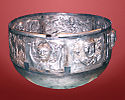- Mag Mell
-
In Irish mythology, Mag Mell (modern spelling: Magh Meall, meaning "plain of joy") was a mythical realm achievable through death and/or glory (see also Valhalla in Norse mythology, Tír na nÓg also from Irish mythology and Avalon in Arthurian romances). Unlike the underworld in some mythologies, Mag Mell was a pleasurable paradise, identified as either an island far to the west of Ireland or a kingdom beneath the ocean. However, Mag Mell was similar to the fields of Elysium in Greek mythology, and like the fields of Elysium, was accessible only to a select few. Furthermore, Mag Mell, like the numerous other mystical islands said to be off the coast of Ireland, was never explicitly stated in any surviving mythological account to be an afterlife. Rather, it is usually portrayed as a paradisal location populated by deities, which is occasionally visited by some adventurous mortals. In its island guise it was visited by various Irish heroes and monks forming the basis of the Adventure Myth or "echtrae" as defined by Myles Dillon in his book Early Irish Literature. This otherworld is a place where sickness and death do not exist. It is a place of eternal youth and beauty. Here, music, strength, life and all pleasurable pursuits come together in a single place. Here happiness lasts forever, no one wants for food or drink. It is the Irish equivalent of the Greek Elysium or the Valhalla of the Norse.
Legends say its ruler is the Fomorian King Tethra, or more frequently Manannan mac Lir. Mag Mell's allure extended from the pagan era to Christian times. In later stories, the realm is less an afterlife destination than an Earthly Paradise which adventurers could reach by traveling west from Ireland, often blown off course by providential tempests while on an inspired mission. They typically explore many other fantastic islands before reaching their destination and returning home (or sailing on). Among these voyagers are St. Brendan, Bran mac Febal (see The Voyage of Bran), and Mael Dúin.
Irish monks, being celebrated sailors, doubtless inspired such stories and were inspired by them. They reached and colonized any number of faraway islands, and St. Brendan is even speculated to have reached the New World a thousand years before Columbus.
See also
- Fortunate Isles
- Valhalla
- Aaru
- Heaven
- Aericura
- Aillen
- Sídhe
- Hy-Brasil
References
- James MacKillop, Dictionary of Celtic Mythology, Oxford: 1998. ISBN 0-19-860967-1
Afterlife locations Buddhism: Celtic: Tír na nÓg • Mag MellChristian: Heaven (Christianity) • Hell • Kingdom of God • Garden of Eden • Paradise • New Jerusalem • Pearly gatesAncient Egyptian: Germanic: Ancient Greek: Hindu: Indo-European: Islamic: Jewish: Garden of Eden • Olam Haba • SheolMesoamerican: Mormon: Native American Persian Taoist Chinese Japanese Wicca Theosophy Related concepts: Millennialism • Utopianism • Great unity • Golden age • Arcadia • Avalon • The Guf • Well of Souls • Republic of Heaven • Existential planes • UnderworldCelts Ancient Celts
Celtic studiesPlacesGaelic Ireland · Dálriata / Alba · Iron Age Britain / Roman Britain / Sub-Roman Britain ·
Iron Age Gaul / Roman Gaul · Galatia · Gallaecia · Britonia · Balkans · TransylvaniaReligionSociety
Modern Celts
Celtic RevivalLanguages Proto-Celtic · Insular Celtic (Brythonic · Goidelic) · Continental Celtic (Celtiberian · Gaulish · Galatian · Gallaecian · Lepontic · Noric)Festivals Lists Celts · Tribes · Deities · English words of Celtic origin · Spanish words of Celtic origin · Galician words of Celtic origin · French words of Gaulish originCategories:- Irish mythology
- Concepts of Heaven
- Locations in Celtic mythology
- Utopias
- Fictional islands
- Fictional countries
- Mythological islands
Wikimedia Foundation. 2010.

